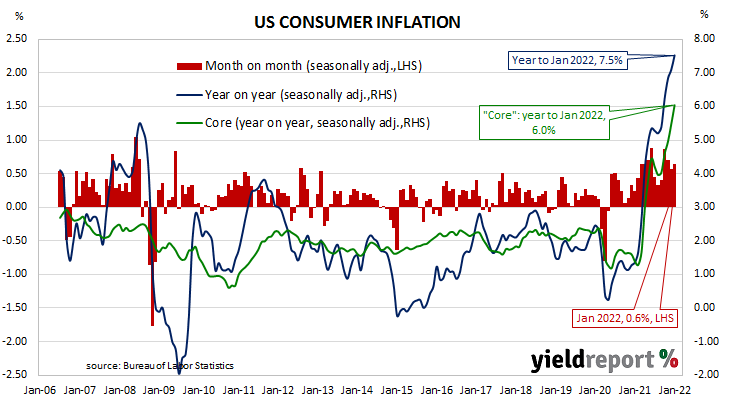Summary: US CPI increases by 0.6% in January, above expectations; “core” rate up 0.6%; CPI “hot”, “broad-based”; Treasury yields jump, rate rise expectations harden; US consumers paying price for “rampant” inflation; rents, non-energy commodities, main drivers of headline rise.
The annual rate of US inflation as measured by changes in the consumer price index (CPI) halved from nearly 3% in the period from July 2018 to February 2019. It then fluctuated in a range from 1.5% to 2.0% through 2019 before rising above 2.0% in the final months of that year. Substantially lower rates were reported from March 2020 to May 2020 and they remained below 2% until March this year. Rates has risen significantly since then.
The latest CPI figures released by the Bureau of Labor Statistics indicated seasonally-adjusted consumer prices increased by 0.6% on average in January. The result was slightly higher than the 0.5% increase which had been generally expected and on par with December’s rise. On a 12-month basis, the inflation rate accelerated from December’s reading of 7.1% to 7.5%.
“Headline” inflation is known to be volatile and so references are often made to “core” inflation for analytical purposes. Core inflation, a measure of inflation which strips out the more variable food and energy components of the index, increased by 0.6% on a seasonally-adjusted basis for the month. As with the headline result, the rise was 0.1 percentage points above the consensus expectation and in line with December’s 0.6% increase. The annual growth rate increased from 5.5% to 6.0%.
“US CPI came in hot with both core and headline one-tenth more than expected. More importantly price pressures were very broad-based,” said NAB senior economist Tapas Strickland.
US Treasury bond yields surged on the day, especially at the short end. By the close of business, the 2-year Treasury yield had jumped 23bps to 1.60%, the 10-year yield had gained 10bps to 2.05% while the 30-year yield finished 8bps higher at 2.33%.
In terms of US Fed policy, expectations for a higher federal funds rate over the next 12 months hardened noticeably. At the close of business, March contracts implied an effective federal funds rate of 0.375%, 29bps higher than the current spot rate while June contracts implied 0.965%. February 2023 futures contracts implied an effective federal funds rate of 1.82%, 174bps above the spot rate.
ANZ economist Kishti Sen noted a “sharp” increase in rental prices over the month and said, “The latest inflation data for the US shows consumers are paying the price for rampant inflation, as the January inflation data far exceeded expectations.”
The largest influence on headline results is often the change in fuel prices. “Energy commodities”, the segment which contains vehicle fuels, declined by 0.8%, subtracting 0.03 percentage points. However, prices of non-energy services, the segment which includes actual and implied rents, had the largest effect in January, adding 0.23 percentage points after they increased by 0.4% on average. Commodities excluding food and energy also had a significant impact after prices rose by 1.0% on average over the month.



